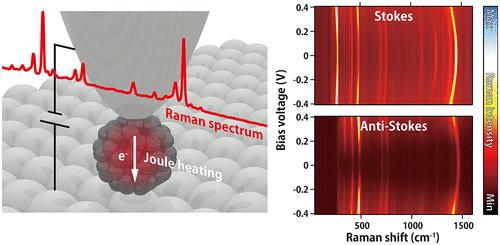Our official English website, www.x-mol.net, welcomes your feedback! (Note: you will need to create a separate account there.)
Joule Heating in Single-Molecule Point Contacts Studied by Tip-Enhanced Raman Spectroscopy
ACS Nano ( IF 15.8 ) Pub Date : 2022-10-05 , DOI: 10.1021/acsnano.2c05642 Borja Cirera 1 , Martin Wolf 1 , Takashi Kumagai 1, 2
ACS Nano ( IF 15.8 ) Pub Date : 2022-10-05 , DOI: 10.1021/acsnano.2c05642 Borja Cirera 1 , Martin Wolf 1 , Takashi Kumagai 1, 2
Affiliation

|
Heating and cooling in current-carrying molecular junctions is a crucial issue in molecular electronics. The microscopic mechanism involves complex factors such as energy inputs, molecular properties, electrode materials, and molecule–electrode coupling. To gain an in-depth understanding, it is a desired experiment to assess vibrational population that represents the energy distribution stored within the molecule. Here, we demonstrate the direct observation of vibrational heating in a single C60 molecule by means of tip-enhanced Raman spectroscopy (TERS). The heating of respective vibrational modes is monitored by anti-Stokes Raman scattering in the TERS spectra. The precise control of the gap distance in the single-molecule junction allows us to reveal a qualitatively different heating mechanism in distinct electron transport regimes, namely, the tunneling and single-molecule point contact (SMPC) regimes. Strong Joule heating via inelastic electron–vibration scattering occurs in the SMPC regime, whereas optical heating is predominant in the tunneling regime. The strong Joule heating at the SMPC also leads to a pronounced red shift of the Raman peak position and line width broadening. Furthermore, by examining the SMPC with several types of contact surfaces, we show that the heating efficiency is related to the current density at the SMPC and the vibrational dissipation channels into the electrode.
中文翻译:

通过尖端增强拉曼光谱研究单分子点接触中的焦耳热
载流分子结中的加热和冷却是分子电子学中的一个关键问题。微观机制涉及能量输入、分子性质、电极材料和分子-电极耦合等复杂因素。为了深入了解,评估代表存储在分子内的能量分布的振动群体是一个理想的实验。在这里,我们展示了对单个 C 60中振动加热的直接观察分子通过尖端增强拉曼光谱(TERS)。通过 TERS 光谱中的反斯托克斯拉曼散射监测各个振动模式的加热。单分子结中间隙距离的精确控制使我们能够在不同的电子传输状态下,即隧道效应和单分子点接触 (SMPC) 状态下揭示质量不同的加热机制。强焦耳加热通过非弹性电子振动散射发生在 SMPC 区域,而光学加热在隧穿区域中占主导地位。SMPC 处的强焦耳加热也导致拉曼峰位置的明显红移和线宽展宽。此外,通过检查具有多种接触表面的 SMPC,我们表明加热效率与 SMPC 处的电流密度和进入电极的振动耗散通道有关。
更新日期:2022-10-05
中文翻译:

通过尖端增强拉曼光谱研究单分子点接触中的焦耳热
载流分子结中的加热和冷却是分子电子学中的一个关键问题。微观机制涉及能量输入、分子性质、电极材料和分子-电极耦合等复杂因素。为了深入了解,评估代表存储在分子内的能量分布的振动群体是一个理想的实验。在这里,我们展示了对单个 C 60中振动加热的直接观察分子通过尖端增强拉曼光谱(TERS)。通过 TERS 光谱中的反斯托克斯拉曼散射监测各个振动模式的加热。单分子结中间隙距离的精确控制使我们能够在不同的电子传输状态下,即隧道效应和单分子点接触 (SMPC) 状态下揭示质量不同的加热机制。强焦耳加热通过非弹性电子振动散射发生在 SMPC 区域,而光学加热在隧穿区域中占主导地位。SMPC 处的强焦耳加热也导致拉曼峰位置的明显红移和线宽展宽。此外,通过检查具有多种接触表面的 SMPC,我们表明加热效率与 SMPC 处的电流密度和进入电极的振动耗散通道有关。






































 京公网安备 11010802027423号
京公网安备 11010802027423号